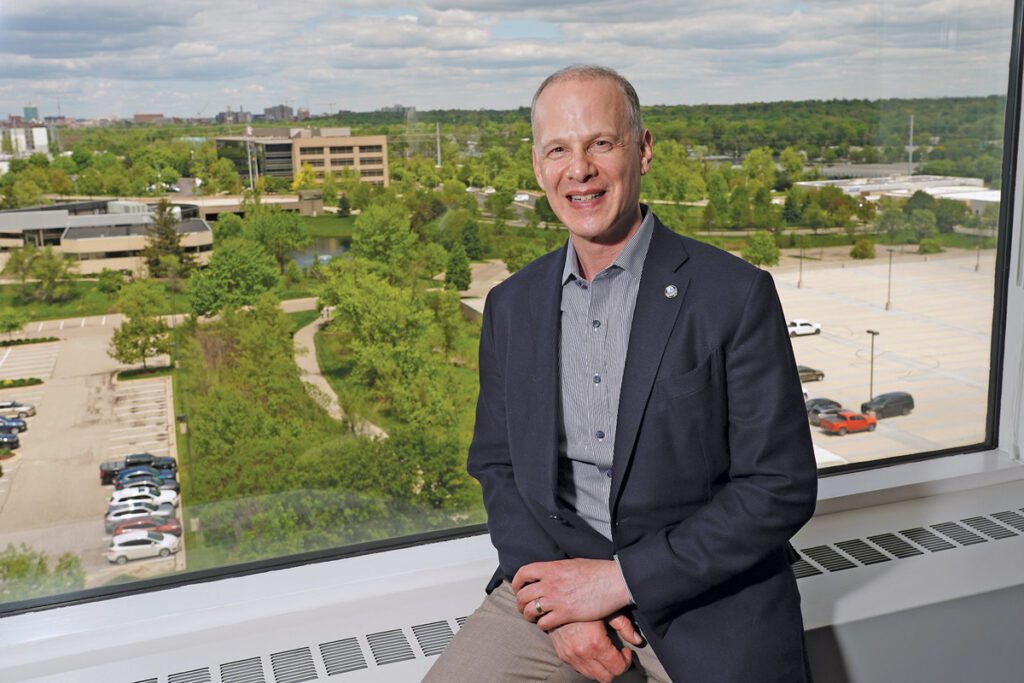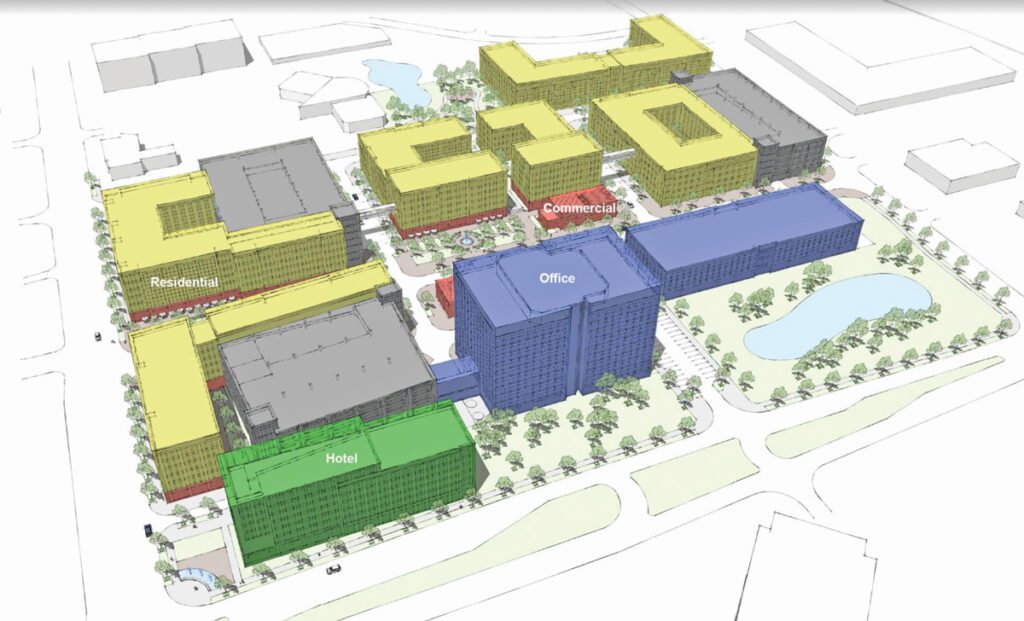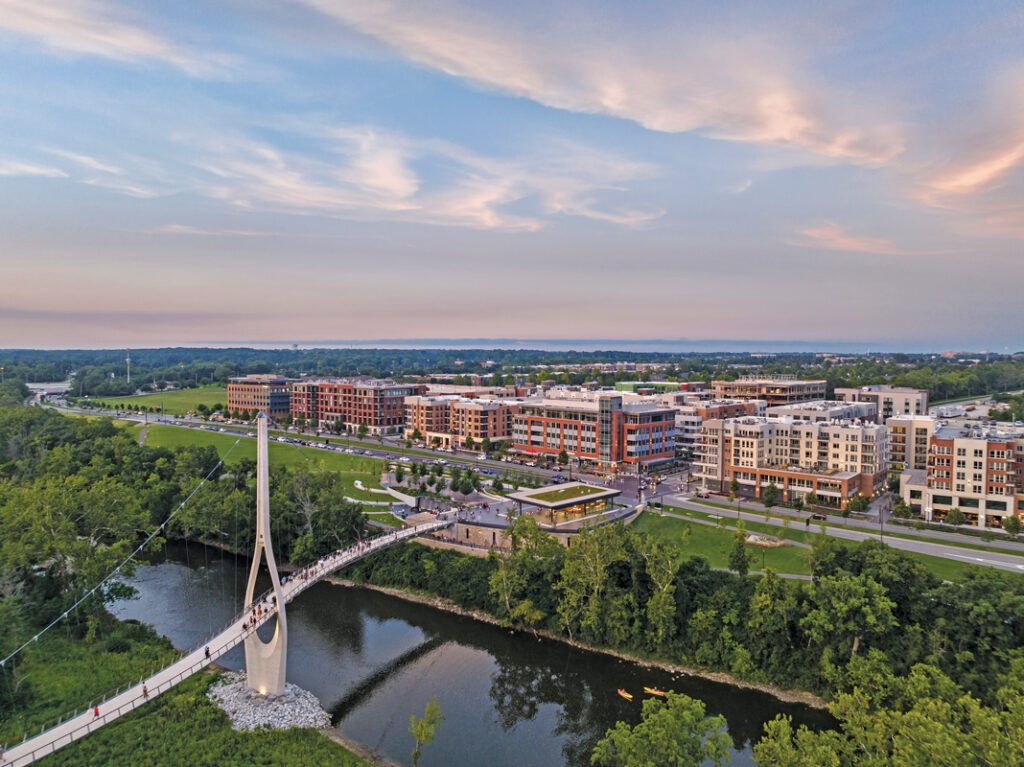
Jeff Hauptman, CEO of Oxford companies. | Photo by J. Adrian Wylie
“That’s a lot of asphalt!”
Jeff Hauptman’s office on the eighth floor of the 777 Building at Eisenhower and State has stunning views north to the U-M campus and downtown. But when he toured the building seven years ago, what really stayed with him was what he saw when he looked down—and saw how much space was used for nothing but parking cars.
“This entire floor, both sides, had been gutted,” the CEO of Oxford Companies recalls. “Concrete floor, zero walls, nothing in the ceiling.” The building’s then-owners were hosting an event with SPARK, the economic development group on whose board he sits. At the time, most of the building was vacant, and the owners were “trying to get people to come and look at the space and imagine what could be done with it.”
Instead, he was wondering what else could be done with the parking lots. “You know—wow!—this seems like such a waste,” he remembers telling the owners’ Chicago-based manager. “And he just kind of looked at me like I was crazy.”
Abundant free parking was a major selling point when suburban office buildings like 777 were built. But acres of asphalt alone were no longer sufficient to persuade tenants to rent its vacant space. The owners “ended up giving up, and they put it on the market,” Hauptman says. “I think we bought the building about a year later.”
Instead of parking, Oxford has emphasized the kinds of amenities that are plentiful downtown, but most suburban office workers must travel to find: There’s a Sweetwaters coffee shop, a Kanbu Sushi stand, and even a 777-branded bike share. With recent leases, Hauptman says, the building is almost 100 percent occupied.
Now he’s eyeing the parking lots again. With a neighboring building owner and an Ohio developer, he plans to replace them with downtown-style parking structures. The partners will use the freed-up space to build 1,000 apartments and condos—plus eating places, public spaces, and a hotel. Two hundred apartments will be affordable housing for people making up to 60 percent of the area median income.
It’s called Arbor South, and Hauptman says it’s a “litmus test.” If it works, he adds, there’s room for as many as 10,000 multifamily units at sites that Oxford already controls.

Arbor South would replace acres of parking lots around the 777 Building and a neighboring office (in blue) with parking structures (gray). They’ll use the freed-up space for housing (yellow), retail (red), and a hotel (green). | Illustration courtesy of Oxford Companies
It’s what city council was hoping for two years ago, when it rezoned the area for dense “transit-oriented development.” And Hauptman expects the benefits to flow in both directions: addressing the city’s housing crisis, he believes, could also ease another crisis, in commercial real estate. The new residents, he says, could revitalize office buildings that have struggled since the pandemic.
Hauptman works at a standup desk with his back to his magnificent view. Instead, he sees photos of his family: He and his wife, consultant Melissa Hauptman, have a blended family of six, ages nine to twenty-one. Life at home, he allows, is “busy.”
Now fifty-four, he grew up on Ann Arbor’s north side, playing soccer (“poorly”) in Sugarbush Park. His father worked at computing company ADP and his mother was a teacher; his brother, Andrew, is now an architect.
Hauptman started working in commercial real estate even before he graduated from the U-M with a degree in urban development. It’s been his life ever since, first at Swisher Commercial and since 1998, at Oxford. Started as a one-person operation, it now fields a crew of 100 who manage three million square feet of office and commercial space in Ann Arbor, as well as a housing portfolio with 1,400 beds.
Summoning up PowerPoint slides on a large-screen display, Hauptman explains why he thinks there’s room to increase that nearly tenfold. One notes that pre-Covid, 85,000 cars entered Ann Arbor every day, with almost half coming up State from I-94.
“Having been involved in this neighborhood for over twenty years, it’s not news to see the cars backed up past Hidden Valley Club” at rush hour, he says. “And I just felt that we could do a lot better.”
Building housing here, he says, “could get a lot of cars off the road.” And while the new structures will have roughly 2,200 parking spaces, that’s only 700 more than the 777 Building and its low-rise neighbor on Eisenhower already have—despite adding 1,000 units of housing, retail space, and a hotel. That’s possible, he says, because most workers will be gone at night and most residents during the day—which “from a sustainability standpoint is beautiful.”
Building on the south side is also cheaper. An acre of land downtown, he says, “is a good $20 million these days. We’re less than sixth of that, in a lot of cases.”
Hauptman has watched downtown’s redevelopment firsthand. His first commercial property, in 1996, was the Galleria mini-mall on South University. He’s since seen student high-rises replace many of the district’s small commercial buildings—and now the Galleria’s turn is coming: Its partners recently accepted an offer from Landmark Properties, the national campus housing developer that already owns five Ann Arbor high-rises and is building a sixth. “They’re pros,” he says. “They know how to develop towers—student towers specifically.”
It’s not just land that costs less away from downtown, he adds: Because most parcels are much bigger—the Arbor South site is almost twenty acres—construction is far more efficient. “First off, we’re building a thousand units, so we have scale,” he says. And compared to downtown, where sites are hemmed in by streets and buildings, “we have the whole site under our control.”
On the big screen, Hauptman switches from PowerPoint to Google Earth. He flies over Ohio to zoom in on a cluster of buildings along the Scioto River outside Columbus. They’re set on an old-fashioned street grid but are so pristine that it might be a computer rendering, if not for signs of ongoing construction.
“This is Bridge Park, Dublin, Ohio,” he says. “For anyone curious about what we’re trying to do here, all you have to do is visit Bridge Park.” Named for the graceful white pedestrian bridge that connects it to Dublin’s downtown, it’s being built by one of Oxford’s partners in Arbor South, Crawford Hoying.

Hauptman found inspiration—and a partner—in Dublin, Ohio’s Bridge Park. While other developers “didn’t want to take the risk of creating a walkable environment,” he says, Bridge Park’s Crawford Hoying “had a shared vision.” | Photo courtesy of Cory Klein Photography
The Dublin-based company is “about $700 to $800 million into this development, and they’re about three-quarters of the way or two-thirds of the way into what they’re planning to do,” says Hauptman. He notes that the street view was taken in August 2022, which means that some buildings shown in progress are probably finished by now. “They’re building stuff so fast Google can’t keep up.”
Oxford sought out Crawford Hoying to design and help build Arbor South because other developers they talked to were only interested in building housing—“they didn’t want to take the risk of creating a walkable environment.” Crawford Hoying, however, “had a shared vision.”
Though Bridge Park’s streets look like a traditional downtown’s, Hauptman points out, they’re designed so “you can shut down a whole area” to host events like concerts and farmers markets. The layout “still allows cars to come and park” he says, but “the whole area is now a very walkable place.”
The company’s executive vice president of design and development, Russ Hunter, took that concept even further at Arbor South, Hauptman says: Plans call for “an almost two-acre park in the middle of this development.”
Crawford Hoying chief operating officer Jeremiah Thomas joins by video to explain their thinking. “Something that’s been true for most of human history is that people flock to locations where there’s a connected living experience,” he says, “where my housing can be adjacent to the places that I entertain myself, to the places that I interact with my community around me, to the place where I work.”
It’s only relatively recently, Thomas says, that developers began to build “housing that was disconnected from services.” Creating places where people can connect isn’t so much a new idea, he says, as “a renewal of an age-old principle.”
Arbor South’s buildings, like Bridge Park’s, will be relatively affordable mid-rises set on a rectangular street grid. But Thomas says that they will look very different.
“What we’ve done at Bridge Park is create a community that is very authentic to Dublin, Ohio, and we want to bring the same energy to Ann Arbor,” he says. “We’re very reflective of the fact that Ann Arbor and Dublin are not the same place.” Designed by Detroit architects Lord Aeck Sargent, Arbor South “is going to be uniquely Ann Arbor.”
At Oxford, Hauptman says, “We like to feel that we want to be the nicest property on the street. We don’t want to be an owner that just simply is trying to get the most dollars out of their real estate. We look at it as part of the community.
“I don’t have any trouble falling asleep at night because of the way I deal with business in town or how one of the properties is being treated. You know, banks and work-from-home certainly will keep me up—but that’s a whole ‘nother story.”
The other story is that commercial real estate still hasn’t recovered from the pandemic. Some offices that went dark during the shutdowns never reopened. Other tenants didn’t renew their leases or shrank their footprints.
With less rent coming in, building values dropped just as interest rates soared. In March, a New York bank needed a $1 billion rescue after losing hundreds of millions on commercial real estate loans, raising fears of a larger financial crisis.
“It is definitely tough times,” Hauptman says, and “the interest rates have made it even crazier. Interest rates are almost double what we were paying the last time around for financing.”
Some office properties Oxford manages are doing great, he says, and some aren’t. “That’s just the way the market is these days.” A couple of new leases, he says, “will put 777 at nearly 100 percent occupancy.” A 100,000-square-foot complex nearby on South Industrial Hwy. is also at 100 percent, and others in the area are in the 90 percents. But “we have some buildings that are sitting vacant south of the freeway,” he says, and some of those may be sold.
“It’s not an ego thing,” he says. If it’s in the investors’ best interests, “you sell. Some will get torn down and built into apartments. So it just depends.”
But Oxford itself is moving ahead. “We still have millions of square feet that we oversee,” Hauptman says. “We have an entire residential group that’s running at 100 percent occupancy. We’re hiring. We’re making investments. We’re starting another company right now, a coworking company.”
Thomas says that in Ohio, too, “existing office space is challenged in the marketplace for any variety of reasons.” But that’s not true at Bridge Park. There, “we’re mostly out of office space in our existing buildings, including one that just got a temporary [certificate of] occupancy roughly six weeks ago,” he says. They’re currently working on two more, “because the demand for new offices has been very high.
“The reason we believe that it’s been very high is because people want to come work in a community like the one that we’re designing and building in Arbor South: because there’s vibrancy there,” Thomas continues. “There is a place to go after work. There are people on the street, walking their dogs at night there. There’s a vibrancy at lunchtime, there’s people that want you want to be around—because we’ve ‘amenitized’ the office and the residential by creating this entertainment district.
“And that’s what we believe that we can also create in Arbor South. And it’s what we believe is the future of the rebirth of offices in the country more generally.”
That belief will soon be tested: The partners hope to break ground next spring, and move in their first tenants in 2026.
This article has been edited since it was published in the June 2024 Ann Arbor Observer. Jeff Hauptman’s office location has been corrected.